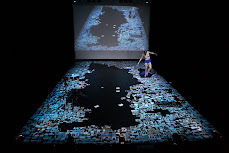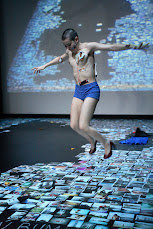According to the wish of Jerzy Grotowski this text is published posthumously.
---------------------------------------------------------------
Untitled Text, by Jerzy Grotowski
--------------------------------------------------------------------------------------------
---------------------------------------------------------------------------------------
It is possible that the end of my life approaches. I should like first of all to
“Action: the last performance of Grotowski”: this information contains three
My last performance, as a theatre director, is entitled Apocalypsis cum figuris.
Action is not a performance. It does not belong to the domain of art as presentation.
When I speak of art as vehicle, I refer to verticality. Verticality — we can
With verticality the point is not to renounce part of our nature — all
So I repeat: Action is not a “performance.” It is an opus entirely created and
Can one say that Action has been a collaboration between Thomas Richards
As for Action, Thomas Richards is its exclusive author.
If I repeat these statements, it is to make a clean sweep before approaching
What can one transmit? How and to whom to transmit? These are questions
Translated from the French by Mario Biagini
Em Junho de 1998…
desloquei-me a Pontedera (Itália), com a equipa artística do Acto. onde assisti à “Action”.
Éramos cinco, Filipe e Christine. (ex-alunos de Jerzy Grotowski), Roberto, Emanuel e eu. Encontrámo-nos à hora marcada, numa pastelaria de Pontedera com Carla Pollastrelli – assistente de Grotowski - e mais tarde juntou-se a nós um estagiário do Workcenter que estava incumbido de nos conduzir ao local.
O Workcenter é um espaço localizado nos arredores da cidade, uma casa relativamente pequena – não é um teatro!! – na altura sem nenhuma indicação exterior, a sinalizar o local, nada que possa auxiliar um forasteiro que ande à procura do local.
Fomos recebidos inicialmente na cozinha, deveríamos ser no total umas 12 pessoas no máximo. Uma cozinha muito modesta, mas onde se respirava um silêncio denso de catedral … passado algum tempo, Mario Biagini apareceu para nos receber, ofereceu-nos algo para beber, sentou-se, acendeu um cachimbo e, muito calmamente, foi-nos explicando que o que iríamos assistir não se tratava de um espectáculo, mas de “uma obra criada no domínio da arte como veículo” que obedece a uma estrutura precisa que vai sendo trabalhada pelos performers ao longo do tempo.
Tinha esperança de ver Grotowski, de saber que energia exalava, se era alto, baixo, como se deslocava… tinha ouvido tantos relatos incríveis a seu respeito, que queria mesmo vê-lo… mas Grotowski não apareceu… soubemos que estava na altura bastante doente… mas não sei se este terá sido de facto o motivo que levou à sua ausência.
Mario Biagini, conduziu-nos depois à sala onde a acção iria decorreu. Era uma sala ao comprido, de chão de madeira, paredes brancas, iluminadas com lâmpadas simples [não! não tinha velas!!] onde estavam dispostos alguns bancos de madeira onde nos sentámos.
Não era um espectáculo, uma peça de teatro, não tinha décor, luzes, figurinos… eram sim, uns sete ou oito “doers” que trabalhavam uma série de acções físicas, acções vocais - a determinada altura pareceu-me ouvir tambores, tais eram as ressonâncias e as vibrações que as vozes faziam ressoar no espaço - corpos plásticos e orgânicos, precisão técnica, energia, mas aqui creio a diferentes níveis, alguns no domínio da energia “heavy but organic” e talvez apenas, creio Mário Biagini e Thomas Richard no outro nível energético.
Tal como diz Grotowski no seu texto acima, a Action, pertence ao domínio da arte como veículo, não ao da arte como representação, não é seu objectivo ser vista ou ser mostrada, apesar de por vezes o poder ser, ela faz parte da procura individual de cada performer ("doer") e não depende de olhares externos… Na altura enquanto estágiária no Acto., assistir à “Action” foi para mim um privilégio incrível… e no entanto saí com a reconfortante sensação de que Grotowski tinha escolhido as pessoas certas a quem transmitir os seus conhecimentos e que
À saída fomos mais uma vez recebidos por Mario Biagini, que com a mesma energia e simplicidade nos conduziu à porta trocando abraços com
Agradecemos e saímos... em silêncio.
Grotowski não apareceu… mas estou certa, esteve sempre lá…
___________________________________________________________________
Fotografia - M. Cułyński, 1997
Vídeo - TVP Polónia

















Nenhum comentário:
Postar um comentário